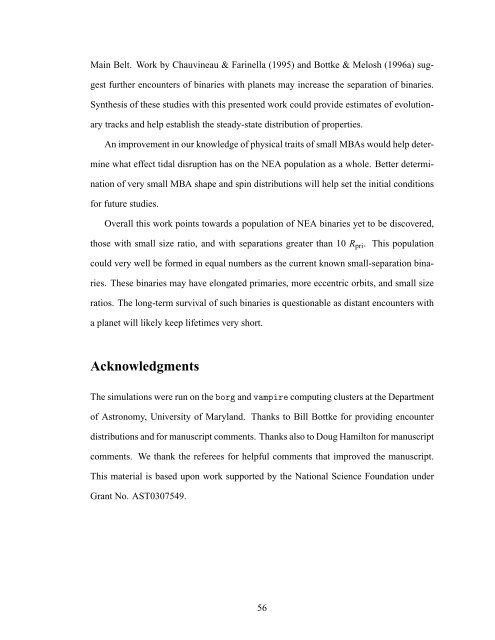Forming Binary Near-Earth Asteroids From Tidal Disruptions
Forming Binary Near-Earth Asteroids From Tidal Disruptions
Forming Binary Near-Earth Asteroids From Tidal Disruptions
You also want an ePaper? Increase the reach of your titles
YUMPU automatically turns print PDFs into web optimized ePapers that Google loves.
Main Belt. Work by Chauvineau & Farinella (1995) and Bottke & Melosh (1996a) suggestfurther encounters of binaries with planets may increase the separation of binaries.Synthesis of these studies with this presented work could provide estimates of evolutionarytracks and help establish the steady-state distribution of properties.An improvement in our knowledge of physical traits of small MBAs would help determinewhat effect tidal disruption has on the NEA population as a whole. Better determinationof very small MBA shape and spin distributions will help set the initial conditionsfor future studies.Overall this work points towards a population of NEA binaries yet to be discovered,those with small size ratio, and with separations greater than 10 R pri . This populationcould very well be formed in equal numbers as the current known small-separation binaries.These binaries may have elongated primaries, more eccentric orbits, and small sizeratios. The long-term survival of such binaries is questionable as distant encounters witha planet will likely keep lifetimes very short.AcknowledgmentsThe simulations were run on the borg and vampire computing clusters at the Departmentof Astronomy, University of Maryland. Thanks to Bill Bottke for providing encounterdistributions and for manuscript comments. Thanks also to Doug Hamilton for manuscriptcomments. We thank the referees for helpful comments that improved the manuscript.This material is based upon work supported by the National Science Foundation underGrant No. AST0307549.56












